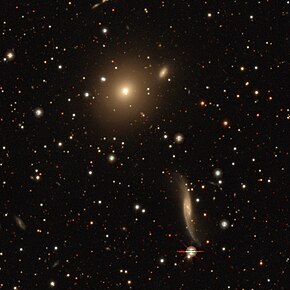NGC 6375
Appearance
| NGC 6375 | |
|---|---|
 NGC 6375 (top) & UGC 10873 (bottom) | |
| Observation data (J2000 epoch) | |
| Constellation | Hercules |
| Right ascension | 17h 29m 21.877s[1] |
| Declination | +16° 12′ 24.47″[1] |
| Redshift | 0.020201[2] |
| Heliocentric radial velocity | 5995 km/s[2] |
| Apparent magnitude (B) | 14.5[2] |
| Characteristics | |
| Type | E[2] |
| Other designations | |
| UGC 10875, MCG +03-44-009, PGC 60384[2] | |
NGC 6375 is a galaxy in the New General Catalog. It is located in the sky within the constellation Hercules. It is an E0 type lenticular, elliptical galaxy. It was discovered by German astronomer Albert Marth in 1864 with a mirror type telescope with a diameter of 121.92 cm (48 inches).[3][4]
References
[edit]- ^ a b Skrutskie, Michael F.; Cutri, Roc M.; Stiening, Rae; Weinberg, Martin D.; Schneider, Stephen E.; Carpenter, John M.; Beichman, Charles A.; Capps, Richard W.; Chester, Thomas; Elias, Jonathan H.; Huchra, John P.; Liebert, James W.; Lonsdale, Carol J.; Monet, David G.; Price, Stephan; Seitzer, Patrick; Jarrett, Thomas H.; Kirkpatrick, J. Davy; Gizis, John E.; Howard, Elizabeth V.; Evans, Tracey E.; Fowler, John W.; Fullmer, Linda; Hurt, Robert L.; Light, Robert M.; Kopan, Eugene L.; Marsh, Kenneth A.; McCallon, Howard L.; Tam, Robert; Van Dyk, Schuyler D.; Wheelock, Sherry L. (1 February 2006). "The Two Micron All Sky Survey (2MASS)". The Astronomical Journal. 131 (2): 1163–1183. Bibcode:2006AJ....131.1163S. doi:10.1086/498708. ISSN 0004-6256. S2CID 18913331.
- ^ a b c d e "NGC 6375". SIMBAD. Centre de données astronomiques de Strasbourg. Retrieved 2020-12-12.
- ^ "NGC 6375". sim-id. Retrieved 2020-07-26.
- ^ "The NGC / IC Project - Home of the Historically Corrected New General Catalogue (HCNGC) since 1993". 2016-05-21. Archived from the original on 2016-05-21. Retrieved 2020-07-26.
External links
[edit]
